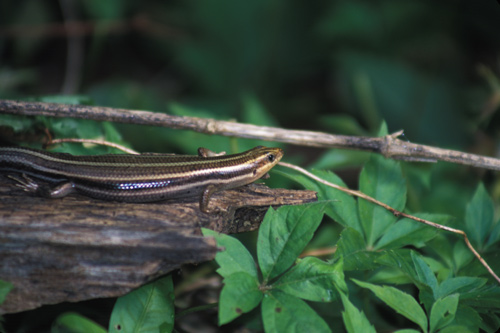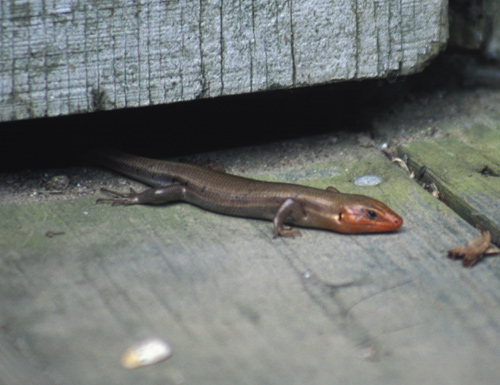The five-lined skink, the only lizard in Connecticut, is rare in the state. Its body is cylindical with short legs. It's tail gradually narrows to a pointy end. It has scales. The age and gender of these skinks affects their coloring. Younger skinks have dark bodies with five white or cream stripes down their back. Their tails will be bright blue. As skinks get older the contrast between the stripes and background color diminishes and the tail fades to gray. Adult females usually show light stripes with a dark band still visible along her sides. Adult males usually become a uniform, medium brown. During mating season the heads of adult males will turn reddish or orange. Five-lined skinks are 5 to 8 inches long.
If something grabs a five-lined skink, they can lose their tail. If the predator was holding the tail, the lizard escapes. The detached tail will also thrash about and this can distract what was bothering the skink. The skink will re-grow a shorter tail.
Five-lined skinks range through sections of the eastern US. They exist in Vermont and Connecticut, south to northern Florida, west to Wisconsin and in some areas by the Great Lakes. They exist in a few isolated populations in Connecticut. Specifically, they are known to be along the Housatonic River in southwestern Litchfield County, along the Housatonic River and the Naugatuck River in northwestern New Haven County and in southwestern Hartford County.
Their prefered habitat is usually areas adjacent to moist deciduous forests that can be steep and rocky but contain some shrub cover, old logs and leaf litter. These skinks are active during day through the warm season. In this area they will hibernate from about October to mid-March. For winter they may dig a burrow below the frost line or hibernate in a crevice, under a log or in a tunnel made by another animal. Sometimes a small number will share a hibernation spot.
The Five-lined skink is a Threatened Species in Connecticut and is protected by law. The Connecticut DEP would like anyone who thinks they have seen one of these elusive lizards to report it to them. However, please don't disturb these rare reptiles.
Five-lined skinks are insect-eaters. Their diet includes insects, snails, spiders and earthworms.
Mating season for five-lined skinks is in April and May. The female digs a nesting hollow in leaf litter or rotten wood in which to lay her 4 to 20 eggs. She guards them for about a month. They typically hatch in Connecticut in August or September. The mother gives no more care to her young after they hatch.
Five-lined skinks live in a solitary fashion. They usually stay on the ground but may climb a tree hunting for insects. They will bask in the sun on rocky ledges or tree stumps.
Neat Facts
Have you seen a lizard or a salamander? Connecticut has several salamanders that can resemble lizards. Salamanders have moist skin, not scales. Lizards like the skink have scales. Salamanders also have no visible ear holes and no claws on their feet. Lizards have both.

